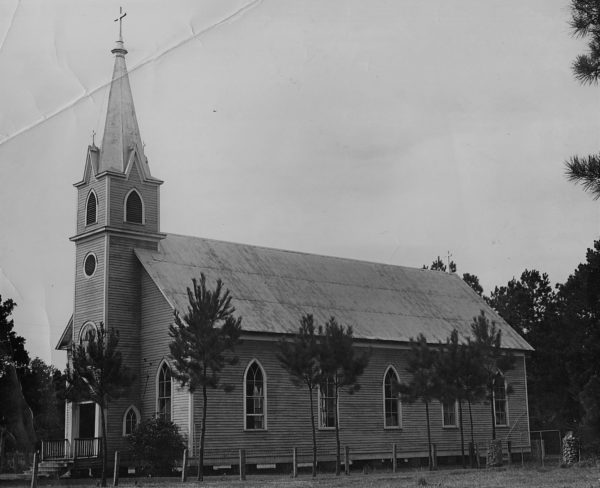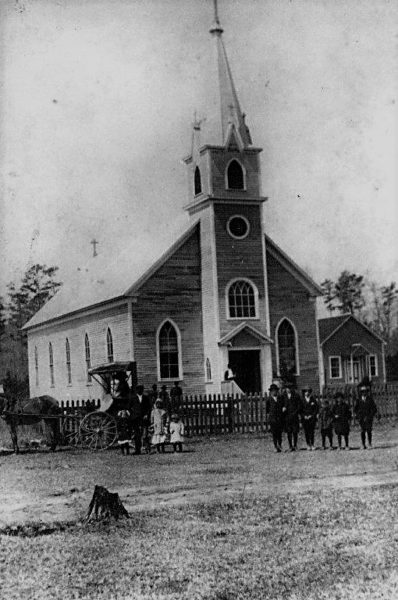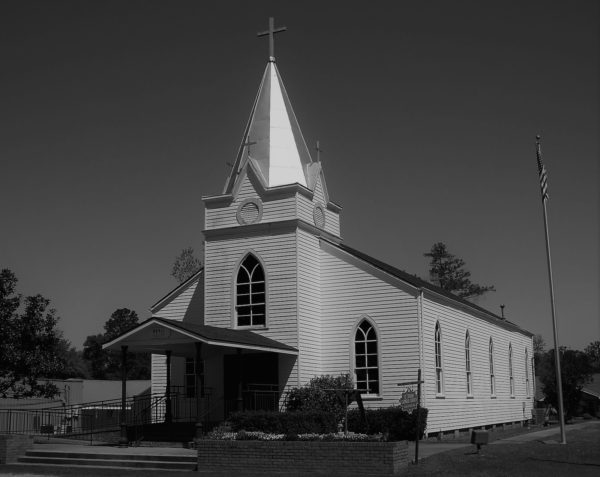Our History
The attraction of work at the local lumber mill and the prospect of purchasing inexpensive cut-over timberland lured Hungarian settlers to Eastern Livingston in the late 19th century.

Adam Mocsary, Julius Bruskay, and Tivador Zborary, workers at the Charles Brackenridge Lumber Company, were among the early migrants who established the Hungarian Settlement in 1896. Word of their success spread, and by 1905, more settlers arrived along with their spiritual needs. The first Masses and other religious services were held in the Immigration House away from the current St. Margaret property.
As the population grew, Catholic Hungarians were desirous of their own place of worship. In 1909, some twenty acres were donated by Mr. and Mrs. Joseph Juhasz for the purpose of constructing a church. Archbishop James Herbert Blenk, the ordinary of the Archdiocese of New Orleans, approved the construction of the Church and the erection of the parish of St. Margaret.
While many of the Hungarian immigrants had a devotion to Margaret of Hungary and hoped the Church would be dedicated to her patronage, she was not canonized until 1943. Church law at the time stipulated that any Church should be named in honor of an officially canonized saint. Thus, the new Parish was entrusted to the honor of St. Margaret, Queen of Scotland; ironically, she was Hungarian by birth but lived her life in exile after the Norman Conquest of England.
The first timber was laid for the Church in 1910; later that year, though incomplete, the current structure was used for religious services. Parishioners recalled attending Mass, able to view the bright Louisiana sunshine overhead while seated inside. Supplies for building were donated by Brackenridge and by Thomas Lumber Company located in Springfield, and construction was slow as all labor was donated too. Most of the construction crew were strawberry farmers by day and church builders on weekends. Construction was finally completed in 1912, and the solemn blessing of the Church took place on 08 September of that same year.
In its formative years, St. Margaret had no resident pastor. Instead, a priest came, by horseback or horse-drawn buggy from Gessen, the site of a Benedictine monastery now known as Rosaryville. Early Benedictine monks would travel the five-mile trek to St. Margaret where the priest would be greeted by young parishioners who were eager to fetch his horse to hitch it to a post at the rear of the church, to water and feed it. These same young parishioners would hitch the horse to a buggy at the conclusion of the Mass so that the priest could resume his pastoral duties elsewhere.
Several religious orders served the Congregation at St. Margaret: Benedictines (1905-1912); Dominicans (1912-1920); the Oblates of Mary Immaculate (1920-1984); and priests of the Diocese of Baton Rouge (1984-Present).

Several milestones are evident in St. Margaret’s history:
- A school was established in 1914 to educate and indoctrinate young Hungarian immigrants; the school closed in 1918.
- An order of consecrated women was founded in 1927 and were housed for several years on the St. Margaret campus. This group, known as the Missionary Catechists, Servants of the Eucharist, were later amalgamated into the Eucharistic Missionaries of St. Dominic which, in turn, were subsumed into the Dominican Sisters of Peace.
- St. Margaret was the Mother Church of Livingston Parish, serving four mission churches simultaneously in its history – St. Mary in Bear Island (currently closed, and now part of the territory of St. Stephen the Martyr Parish in Maurepas), Sacred Heart in Livingston (now a chapel of Immaculate Conception Parish), Immaculate Conception in Denham Springs (now the largest church parish in the Diocese of Baton Rouge), and St. Thomas the Apostle Chapel in Springfield. St. Thomas is still operated by St. Margaret and is served by its pastor.
- An additional 5.05 acres of property to the east of the St. Margaret campus was purchased in 2015 as the first phase in a five-part master plan to address future development needs and growth.
- In 2016, severe flooding affected much of the Greater Baton Rouge area. St. Margaret and her parishioners served the needy in our community by providing shelter to thousands of motorists stranded on Interstate 12, provided emergency financial needs to flooded parishioners including gift cards, cleaning materials, food, and over 1,000 sheets of sheetrock, and distributed $350,000 in furniture to flood victims.
- In 2018, a $2.1 million capital improvement plan was implemented to restore and beautify parochial buildings including St. Margaret Church; from 2012-2017, the Parish Rectory and Hall of Saints were totally renovated as well.
St. Thomas the Apostle Chapel, Springfield

By today’s standards, St. Thomas Chapel is geographically proximate to the mother Church of St. Margaret. When it was established in 1940, though, an extra four miles of travel proved often to be difficult and fraught with potential danger. There was an evident need for a church facility in the town of Springfield.
The present site of the chapel was donated by Marcus Rownd in 1922, but the donation was not completed or duly entered into court records until 29 June 1932. At the request of Archbishop Joseph Francis Rummel of New Orleans, architectural plans were created in 1939. Construction of the chapel was financed by the Sloo family of New Orleans in memory of their son Thomas. There was only one request of the family – that the new chapel bear the name of Thomas the Apostle, their son’s namesake. The chapel was formally dedicated in 1940.
The Sloo family also established a trust with a large sum of money for the upkeep and future maintenance of the Chapel. In 1991, this endowment was dissolved which enabled the congregation to undertake a complete renovation of the structure.
In the first twenty years of its history, Masses were celebrated only twice per month. The Eucharist is currently celebrated every Sunday.
-
Are the St. Margaret Church and St. Thomas Chapel we attend today the original structures?
While both have undergone several renovations from their inception, St. Margaret Church is the current structure built by Hungarian immigrants in 1910, and St. Thomas the Apostle Chapel is the original building constructed because of the generosity of the Sloo family in 1940.
-
Who was St. Margaret, Queen of Scotland?
Margaret of Scotland was born in 1045 in Hungary and died 16 November 1093 in Edinburgh. Upon fleeing to Scotland after the Battle of Hastings, she married Malcom III of Canmore despite her interests in consecrated life. She was able influence her husband and his court where she promoted interests in the Gregorian reforms and in service and charity toward the poor. She died shortly after her husband was slain near Alnwick, Northumberland and was canonized in 1250. Her feast is November 16 – the date of her death.
-
What architectural style is St. Margaret Church?
While many refer to it as “the little country Church by the Interstate,” St. Margaret is a Gothic Revival style Church built in 1910. It was added to the National Register of Historic Places in 1992.
-
Are there any plans to build a new church?
As the population of Livingston Parish continues to increase, St. Margaret continues to evolve and grow too! In 2018, the congregation engaged in a $3.5 million project to expand and restore the Church, provide paved parking, and beautify the parochial grounds. The goal is to preserve our past and to move forward into the future. The fifth phase of our Master Plan eventually involves the building of a new worship space. Upon its completion, the current St. Margaret Church will serve as a chapel for weddings, funerals, Eucharistic Adoration, and daily Mass.